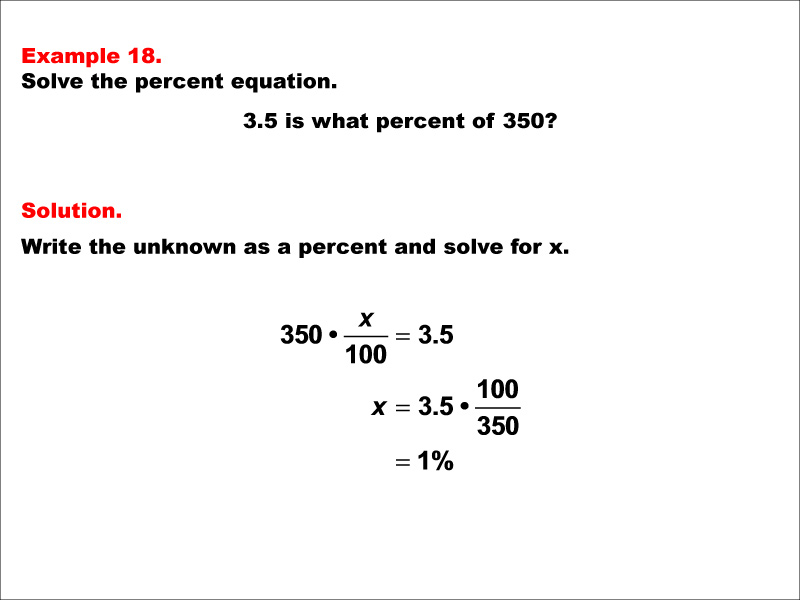
Display Title
Math Example--Percents--Equations with Percents: Example 18
Display Title
Math Example--Percents--Equations with Percents: Example 18

Topic
Solving Equations
Description
This math example demonstrates solving percent equations by asking "3.5 is what percent of 350?" The solution involves setting up the equation 350 * (x / 100) = 3.5, then solving for x to get x = 3.5 * (100 / 350), which equals 1%. This example introduces a scenario where the resulting percentage is a whole number (1%) and involves a decimal number as the first value.
Solving equations with percents is a fundamental skill in mathematics that has wide-ranging applications in finance, statistics, and data analysis. These examples help students understand how to set up and solve equations involving percentages, especially in cases where the result is a simple, whole percentage. This skill is crucial for more advanced mathematical concepts and real-world problem-solving scenarios, such as calculating percentage changes, analyzing proportions in large datasets, or understanding relative values in various contexts.
The importance of presenting multiple worked-out examples cannot be overstated. Each new example reinforces the concept while introducing different scenarios, including those with decimal numbers and whole number percentages. This approach helps students recognize patterns, adapt their problem-solving strategies, and gain confidence in their ability to handle diverse percentage-based calculations. By practicing with various value pairs, including those that result in simple percentages, students develop a more comprehensive understanding of how percentages relate different quantities and prepare for more complex mathematical challenges they may encounter in higher education or professional settings.
Teacher Script: "Let's tackle this interesting percent problem. We're asked, '3.5 is what percent of 350?' To solve this, we set up the equation 350 * (x / 100) = 3.5. Now, how do we solve for x? We multiply both sides by 100/350. This gives us x = 3.5 * (100 / 350), which simplifies to 1%. Notice that our result is a whole number percentage. This means that 3.5 is exactly 1% of 350. In real-world scenarios, you might encounter situations where you need to express one value as a percentage of another, much larger value. For example, if a company's profit increased by $3.5 million when their total assets were $350 million, they could report a 1% increase in profitability. Understanding these concepts is crucial for analyzing financial data, comparing values in large datasets, and interpreting proportions in various fields like business, economics, and social sciences."
For a complete collection of math examples related to Solving Equations click on this link: Math Examples: Equations with Percents Collection.
| Common Core Standards | CCSS.MATH.CONTENT.6.EE.B.5, CCSS.MATH.CONTENT.7.RP.A.3, CCSS.MATH.CONTENT.6.RP.A.3.C |
|---|---|
| Grade Range | 5 - 8 |
| Curriculum Nodes |
Algebra • Expressions, Equations, and Inequalities • Solving Percent Equations |
| Copyright Year | 2013 |
| Keywords | Percent, equation, solution, solving equation, percentage |